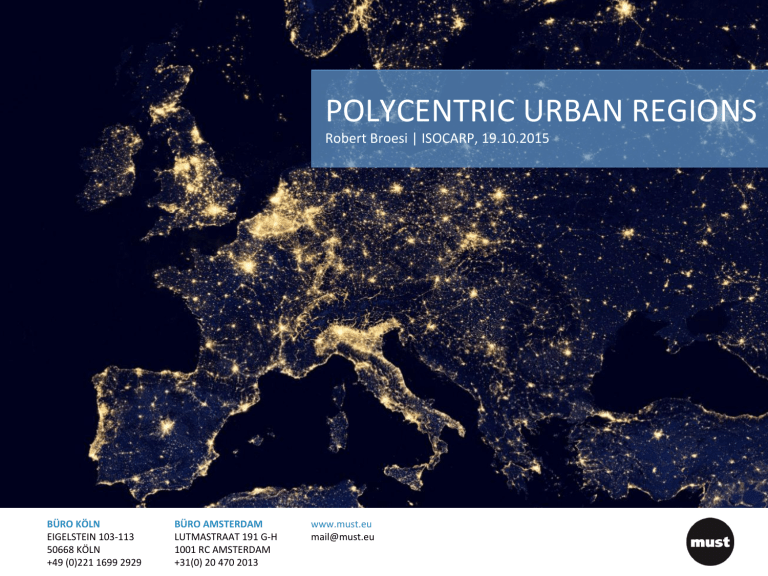
POLYCENTRIC URBAN REGIONS Robert Broesi | ISOCARP, 19.10.2015 BÜRO KÖLN EIGELSTEIN 103-­‐113 50668 KÖLN +49 (0)221 1699 2929 BÜRO AMSTERDAM LUTMASTRAAT 191 G-­‐H 1001 RC AMSTERDAM +31(0) 20 470 2013 www.must.eu [email protected] Economy is scaling up, governance is scaling down Source: Frank van Oort (with Mar_jn Burger, Henri de Groot, Evert Meijers, Mar_jn Smit Trends in global economy Global Economy: shift to urban regions with mass and size?
“It is a common misperception that megacities have been driving
global growth for the past 15 years. In fact, most have not grown faster
than their host economies.
Today's 23 megacities—with populations of 10 million or more—will
contribute about 10 percent of global growth to 2025.”
“In contrast, 577 middleweights—cities with populations of between
150,000 and 10 million, are seen contributing more than half of
global growth to 2025, gaining share from today's megacities.” (Mc
Kinsey, 2011)
Polycentric urban regions What is the position of polycentric urban regions?
1) How do we organise the economy and the quality of life of
polycentric urban regions in a global economy?
2) How to overcome cross border issues?
3) Role of planning?
GROW! versus Borrowed Size Strategies GROW! GROW! Why think on a local urban scale?
•
Agglomeration gives a premium on productivity (+5%)
•
Labour markets are localized
•
Subcontracting may be facilitated by proximity (trust)
• Policy structure / devolution strives for local power
•
Institutions / culture mould economic interaction
•
Competition leads to favoring own strengths
•
Knowledge spillovers are localized to a large extent
•
Consumer City and higher educated
Source: Frank van Oort (with Mar_jn Burger, Henri de Groot, Evert Meijers, Mar_jn Smit Borrowed Size Alonso (1973) suggested that economies of scale
from
polycentrism can be achieved:
“in certain European urban patterns, such as those
of Germany and the Low Countries,
whose cities, quite small by our standards,
apparently achieve sufficient scale for the
functioning of a modern economy by
borrowing size from one another” (p. 200).
Source: Frank van Oort (with Mar_jn Burger, Henri de Groot, Evert Meijers, Mar_jn Smit Borrowed Size Why think on larger scale?
•
Trade networks are global
•
Structuring corridors are interregional
•
Technological and societal transitions are universal
•
An institutional goal may be integration (e.g. cities, EU)
•
There are common problems and challenges in multiple regions:
accessibility, governance, sustainability, growth, demographic change •
Regions may borrow size or functions from each other
(polycentricity)
and together also have the 5% premium,
given physical, functional and
governance relatedness.
Source: Frank van Oort (with Mar_jn Burger, Henri de Groot, Evert Meijers, Mar_jn Smit Borrowed Size Van Oort e.a.
“The concept of borrowed size can lead to the
same positive effects as the concept of
agglomeration but...
…THERE HAS TO BE SOMETHING THAT CAN BE
BORROWED, COMPLEMENTED OR COMPETED ”
Source: Frank van Oort (with Mar_jn Burger, Henri de Groot, Evert Meijers, Mar_jn Smit Case Study – ABC Region (Van Oort) Economic knowledge complementarities
Source: Frank van Oort (with Mar_jn Burger, Henri de Groot, Evert Meijers, Mar_jn Smit Case Study – ABC Region (Van Oort) Scenario 7: Zef Hemel Source: Frank van Oort (with Mar_jn Burger, Henri de Groot, Evert Meijers, Mar_jn Smit Case Study – ABC Region (Van Oort) Scenario 7: UrbanizaFon Source: Frank van Oort (with Mar_jn Burger, Henri de Groot, Evert Meijers, Mar_jn Smit Case Study – ABC Region (Van Oort) Scenario 6: Borrowed Size Source: Frank van Oort (with Mar_jn Burger, Henri de Groot, Evert Meijers, Mar_jn Smit Case Study – ABC Region (Van Oort) Scenario 4: without borders Source: Frank van Oort (with Mar_jn Burger, Henri de Groot, Evert Meijers, Mar_jn Smit Case Study – ABC Region (Van Oort) Source: Frank van Oort (with Mar_jn Burger, Henri de Groot, Evert Meijers, Mar_jn Smit Case Study – ABC Region (Van Oort) Conclusions
1. CiFes & urbanizaFon are important 2. Borrowed size (func_ons, performance) is important 3. Investments in place-­‐based and in connec_ng network-­‐ and governance (coopera_on) structures are needed (in tandem) -­‐ for trading, learning, sharing & matching 4. There is a common governance responsibility across all scales and stakeholders of the regional economic ecosystem to make these structures! 5. Coopera_on can do or complement what larger-­‐scale urban governance can do – but does it? Source: Frank van Oort (with Mar_jn Burger, Henri de Groot, Evert Meijers, Mar_jn Smit Aachen – Maastricht – Luik Region Source: Grensoverschrijdend perspec_ef Zuid-­‐Limburg Aachen – Maastricht – Luik Region Source: Grensoverschrijdend perspec_ef Zuid-­‐Limburg Cross border issues Cross border regions in EU Overview of cross-border
cooperation initiatives
between small and medium cities
in Europe
[email protected] [email protected] Challenges 1. To combine the means, know-how and resources to acquire a
critical mass
• By pooling resources to set up and operate large scale infrastructure
projects or events.
• By fostering the networking of competencies in order to generate
innovation.
Health Educa_on Research Environment Economy [email protected] [email protected] Challenges 2. To bring more “spatial & functional coherence” through the
elaboration of common territorial strategies
[email protected] [email protected] Challenges 3. To provide an international image of the cross-border region
• Through the promotion of the territory to foreign investors
• Through the development of a more attractive and welcoming image
of the cross-border area
[email protected] [email protected] Influencing factors 1. The belonging to a transnational space such as the EU, the
Schengen area or the Eurozone and/or the history of cooperation
2. Spatial configurations between small and medium cities
In cross-border agglomerations, the authorities are
confronted with the necessity to manage together
local services and infrastructures.
The “distance collaboration” within polycentric
regions is often more flexible and focused on a
limited number of strategic collaborations.
[email protected] [email protected] Influencing factors 3. The cross-border governance structures
Some general principles to improve cross-border governance:
•
To open the governance arena to non-institutional actors
•
To use the available legal instruments and means
• … But the quality of interpersonal relations between
policymakers remains crucial to ensure an efficient cooperation!
[email protected] [email protected] Influencing factors 4. The feeling of sharing a common cross-border living area
Events and actions can develop the sense of belonging to a cross-border
community of interests.
[email protected] [email protected] Ques_ons for the workshop •
How do you view the chances of GROW! and Borrowed Size?
•
Do these strategies also apply for “in between” polycentric
regions like the Aachen – Maastricht – Luik / Genk region?
•
Or is there a different, more relevant strategy?
Ques_ons for the workshop •
What is the size (distance / time) of a daily urban system?
•
“Connecting the dots”: What should be borrowed,
complemented? And how to identify these functions?
•
How should be dealt with the cross border issues?
•
What is the role of planning in enhancing polycentric, cross
border regions?











